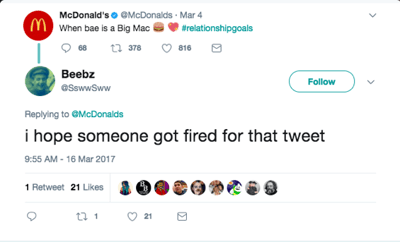When it comes to social media for businesses, there’s an undeniable pressure to be funny and edgy. It’s become commonplace for brands on social media to join in on the current conversations sweeping the nation, armed with a stockpile of GIFs, memes, and topical references.
But perhaps it’s time to ask — just how important is it to be clever on social media?
There’s a notable uptick in these efforts when a company darts into the national spotlight, like when Wendy’s first adopted its sassy approach to community management. When Wendy’s got involved in #NuggsForCarter and what would eventually become the most retweeted tweet of all time at 3.6 million retweets, other brands jumped on the opportunity. Microsoft, United, and Amazon all retweeted the message on their corporate accounts.
It’s easy to feel inspired when these daring risks pay off big-time. But more often than not, this approach backfires in small ways. Many companies end up trying a little too hard, enduring ridicule from those who were supposed to be potential new leads and loyal customers.
In fact, the Q2 2017 Sprout Social Index reveals some interesting facts about audience attitudes surrounding these common brand behaviors.
To break down a few of the findings and discuss how they translate into a brand’s social media engagement strategy, let’s explore some real-life approaches to each tactic.
Discussing politics and taking a stance
71 percent of respondents find it annoying when a brand talks politics on social media.
This is a tough one, because it works against what we know about people’s buying behavior being influenced by a company’s beliefs and values. A recent study by Edelman found that 57 percent of consumers said they are “more likely to buy from or boycott a brand because of its stance on a social or political issue.”
So what accounts for the conflict between these two findings? Consider the way a brand approaches political speech. There’s a clear difference between brands that take up a cause and reflect their efforts through action, and those that jump on a political bandwagon in the moment.
Take REI. The brand directly calls on its customers to take action for a political cause. But if you delve into the comments section, you don’t see those survey results materialized. Rather, the reaction from their audience is almost entirely positive.
 This cause speaks directly to REI’s brand, which is rooted heavily in a mantra of values like “purpose over profits” and “advocate for the outdoors.” This specific example of political discourse likely saw less pushback because it’s not overly opportunistic.
This cause speaks directly to REI’s brand, which is rooted heavily in a mantra of values like “purpose over profits” and “advocate for the outdoors.” This specific example of political discourse likely saw less pushback because it’s not overly opportunistic.
Slang
69 percent of respondents find it annoying when brands use slang on social media.
The survey may label audience attitude as “annoyed,” but businesses that use slang evoke a special kind of exasperation from social media users.
For example, the sheer number of businesses that tweeted variations of brand “bae” posts inspired a Twitter account dedicated solely to spotlighting unfortunate use of the word by brands.
 It’s tough to explain exactly why social media users resent this behavior, beyond its evident cringe factor. Regardless, adopting slang will not automatically make your brand’s social media presence edgier, nor will it guarantee engagement from a younger audience.
It’s tough to explain exactly why social media users resent this behavior, beyond its evident cringe factor. Regardless, adopting slang will not automatically make your brand’s social media presence edgier, nor will it guarantee engagement from a younger audience.
Using GIFs in posts and replies
More than four in ten respondents (42%) say they find it annoying when brands use GIFs.
Safe to say, over half of social media consumers love a solid animated GIF. But really, the success of the GIF when used to engage customers through social media depends on the context.
Yoplait recently put GIFs to good use when engaging with its community after the debut of its latest #MomOn campaign.
 Generally, Yoplait’s GIF replies perform quite well in terms of engagement and sentiment.
Generally, Yoplait’s GIF replies perform quite well in terms of engagement and sentiment.
But joining in on conversations on social media, especially when your brand isn’t outright mentioned or tagged, requires some subtlety and understanding of your audience. If a GIF response seems forced or inappropriate when compared to your brand’s usual voice and tone, things can quickly become uncomfortable.
Risky comebacks on social media
67 percent of respondents find it annoying when brands make fun of their competitors. What’s more, 81 percent of respondents feel that way when brands make fun of their customers.
This stat is particularly interesting when we think about Wendy’s and how it achieved its reputation for social engagement savvy. Wendy’s fame was built around tweeting savage (albeit, joking) replies to its customers.
But here’s the moral of the story: Wendy’s approach, and its customers’ response, are both atypical.
It’s true that some people reach out to brands solely for a fun and memorable interaction. But above all, they are looking for quick customer service and answers to their questions.
Simply put, humor and wit won’t always win over your customers. Always prioritize what your audience wants over trends and a desire to be cool.
If you have examples of brand blunders or successes when it comes to these common practices, we’d love to hear them — so please share in the comments below!




